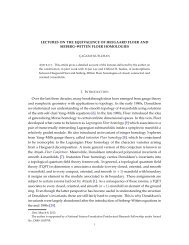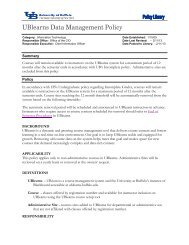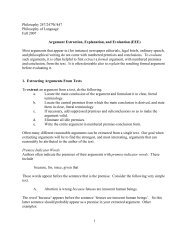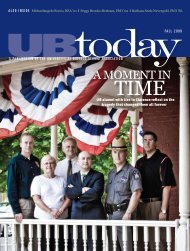A WALK IN THE WOODS - University at Buffalo
A WALK IN THE WOODS - University at Buffalo
A WALK IN THE WOODS - University at Buffalo
Create successful ePaper yourself
Turn your PDF publications into a flip-book with our unique Google optimized e-Paper software.
From Jersey Boy to Cricket Expert:A Ch<strong>at</strong> with UB Prof P<strong>at</strong>rick McDevittP<strong>at</strong>rick McDevitt, associ<strong>at</strong>e professor of history, teaches acourse on the history of sport, and authored the book “Maythe Best Man Win: Sport, Masculinity, and N<strong>at</strong>ionalism inGre<strong>at</strong> Britain and the Empire, 1880-1935” th<strong>at</strong> fe<strong>at</strong>ures twochapters on cricket. He also contributed a book chapter in“The Cambridge Companion to Cricket.” McDevitt servesas the faculty adviser for the UB Cricket Club Associ<strong>at</strong>ion.How long have you been a fan of cricket?“For imperial Britain,cricket was more thanjust a game; it was acode of conduct andthe expression of aBritish and imperialsense of right andwrong.”Excerpt from “The CambridgeCompanion to Cricket”—P<strong>at</strong>rick McDevittI first learned the nuances ofcricket when I moved to NewZealand as a gradu<strong>at</strong>e student in1993. A lifelong baseball fan, it wasan easy transition to make for me.While obviously different games,the two sports share many traits(pace of play, basic movements andobjectives, a fascin<strong>at</strong>ion of st<strong>at</strong>istics,etc.). I think many Americansare intimid<strong>at</strong>ed by cricket, whichin some varieties can last for fivedays. The game th<strong>at</strong> is most oftenplayed is called Twenty20 andtakes the same length of time as abaseball game.Is there a quick and dirty way ofunderstanding the game?The best way for an American to beintroduced to the game is to haveit explained by someone who grewup playing baseball. The transl<strong>at</strong>ion process runs moresmoothly th<strong>at</strong> way.Do you play cricket?I do not play cricket well, although I have certainly playedenough of the driveway and backyard variety over the years.I wouldn’t have the skills to play with the UB Cricket Team.Have you been able to convert any Americans intobecoming fans?I have only passed along my love of cricket to one baseballlovingAmerican, and th<strong>at</strong> is Professor Kristin Stapleton ofthe history department when we were delayed in the NewDelhi airport for six or seven hours and it was on TV.For those of us who are unfamiliar with the game, canyou talk about the meaning of the saying “It’s not justcricket”? Do you use th<strong>at</strong> saying <strong>at</strong> all?While I wouldn’t use “not cricket” in my vocabulary verymuch—I’m just a guy from New Jersey after all—Englishspeakingpeople from around the former British Empirecertainly would. The common usage of the phrase th<strong>at</strong>something was “not cricket” meant simply and succinctlyth<strong>at</strong> it was not morally right.Why do you think cricket hasn’t caught on in a big way inthe U.S.?Cricket didn’t originally c<strong>at</strong>ch on in the U.S. because theorganizers of cricket highlighted its exclusivity and its Anglophilia,while baseball’s early promoters sought a wideraudience and promoted its “Americanness.” The game isgaining popularity in the St<strong>at</strong>es. The New York City PublicSchools now have a cricket championship with more teamsbeing added every year. Increasingly, n<strong>at</strong>ive-born Americans,not just West Indian and South Asian students, areplaying too.Lost in transl<strong>at</strong>ion: Even for fans of the game, cricket terminology is constantly changing. In this cartoon fe<strong>at</strong>ured inPunch magazine from 1920, communic<strong>at</strong>ion woes between gener<strong>at</strong>ions of fans were just as common as today.hit the balltop of the b<strong>at</strong> near the handle (an area of little power)YOUNG CRICKETER “Yes, I cocked one off the splice in thegully and the blighter g<strong>at</strong>hered it.”fielding positionslightly behindthe off-side of thethe b<strong>at</strong>ter‘newish’ slang for a detestable person (possiblyunfamiliar to an older man in 1920)FA<strong>THE</strong>R “Yes, but how did you get out? Wereyou caught, stumped or bowled, or wh<strong>at</strong>?”all ways to be caught out—on the fly, stumps knockedover by hand or stumps knocked over by the bowler30 UBTODAY Spring 2013 www.buffalo.edu/UBT
















